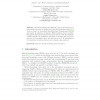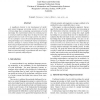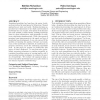112
Voted
ECSQARU
2007
Springer
15 years 4 months ago
2007
Springer
Many merging operators have been proposed to merge either flat or stratified knowledge bases. The result of merging by such an operator is a flat base (or a set of models of the me...
100
Voted
FSTTCS
1999
Springer
15 years 5 months ago
1999
Springer
Abstract. Hybrid knowledge bases (HKB’s) [11] were developed to provide formal models for the mediation of data and knowledge bases [14,15]. They are based on Generalized Annotat...
97
Voted
AI
2000
Springer
15 years 5 months ago
2000
Springer
Abstract. In this paper we focus on the problem of integrating knowledge bases expressed in a description logic. To this end, we propose three basic operations: union, intersection...
110
Voted
ACSC
2000
IEEE
15 years 5 months ago
2000
IEEE
A significant obstacle to the development of intelligent natural language processing systems is the lack of rich knowledge bases containing representations of world knowledge. Fo...
106
click to vote
IEAAIE
2003
Springer
15 years 6 months ago
2003
Springer
A knowledge base is maintained by modifying its conceptual model and by using those modifications to specify changes to its implementation. The maintenance problem is to determine ...
107
click to vote
KCAP
2003
ACM
15 years 6 months ago
2003
ACM
Acquiring knowledge has long been the major bottleneck preventing the rapid spread of AI systems. Manual approaches are slow and costly. Machine-learning approaches have limitatio...
124
click to vote
KR
2004
Springer
15 years 6 months ago
2004
Springer
In this paper, a new method for merging multiple inconsistent knowledge bases in the framework of possibilistic logic is presented. We divide the fusion process into two steps: on...
106
Voted
KR
2004
Springer
15 years 6 months ago
2004
Springer
Although sorts and unary predicates are semantically identical in order-sorted logic, they are classified as different kinds of properties in formal ontology (e.g. sortal and non...
101
click to vote
CAISE
2004
Springer
15 years 6 months ago
2004
Springer
The Semantic Web vision aims to integrate and convert the vast amount of information available on the Internet into a machine-understandable network. The objective is to promote kn...
WISE
2005
Springer
15 years 6 months ago
2005
Springer
OWLIM is a high-performance Storage and Inference Layer (SAIL) for Sesame, which performs OWL DLP reasoning, based on forward-chaining of entilement rules. The reasoning and query ...



